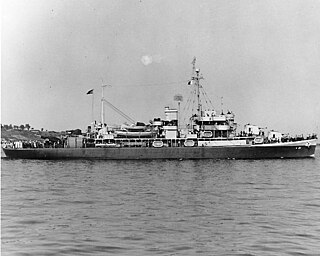
USS Salvager, a Gypsy-class salvage lifting vessel of the United States Navy, was originally conceived as LSM-551, was reclassified ARS(D)-3 on 24 April 1945; named Salvager on 1 May 1945; laid down on 27 August 1945 by the Brown Shipbuilding Corporation, Houston, Texas; launched on 7 December 1945; and commissioned on 22 March 1946.

USS Sandpiper (AM-51) was a Lapwing-class minesweeper. Laid down on 15 November 1918 at the Philadelphia Navy Yard, Philadelphia, Pennsylvania, and launched on 28 April 1919, USS Sandpiper was commissioned on 9 October 1919, redesignated AM-51 on 17 February 1920, and reclassified as a Small Seaplane Tender, AVP-9 on 22 January 1936.

USS Seneca (AT-91) was a Navajo-class fleet tug constructed for the United States Navy during World War II. Her purpose was to aid ships, usually by towing, on the high seas or in combat or post-combat areas, plus "other duties as assigned." She served in the Atlantic Ocean performing various tasks.

USS Diver (ARS-5) was a Diver-class rescue and salvage ship commissioned by the U.S. Navy for service in World War II. She was responsible for coming to the aid of stricken vessels.

USS Escape (ARS-6) was a Diver-class rescue and salvage ship commissioned by the U.S. Navy for service in World War II. She was responsible for coming to the aid of stricken vessels.

USS Preserver (ARS-8) was a Diver-class rescue and salvage ship commissioned by the U.S. Navy for service in World War II. She was responsible for coming to the aid of stricken vessels.
USS Curb (ARS-21) was a Diver-class rescue and salvage ship commissioned by the U.S. Navy during World War II. Her task was to come to the aid of stricken vessels.

USS Safeguard (ARS-25) was a Diver-class rescue and salvage ship in service with the United States Navy from 1944 to 1947 and from 1952 to 1979. She was then transferred to Turkey where she served as TCG Işın (A-589) until 2017.

USS Snatch (ARS-27), well known as Scripps RV Argo after conversion to scientific research, was a Diver-class rescue and salvage ship commissioned by the U.S. Navy during World War II and in service from 11 December 1944 through 23 December 1946. Her task was to come to the aid of stricken vessels. The ship is better known from her scientific research role as the Scripps Institution of Oceanography (SIO) research vessel RV Argo. It is that name, apparently not formally recognized by Navy that maintained title to the vessel, found in the scientific literature and public releases about her wide ranging research voyages.
USS Gear (ARS-34) was a Diver-class rescue and salvage ship acquired by the U.S. Navy during World War II. Her task was to come to the aid of stricken vessels.

USS Hoist (ARS-40) was a Bolster-class rescue and salvage ship acquired by the United States Navy during World War II. Its task was to come to the aid of stricken vessels.

USS Opportune (ARS-41) was a Bolster-class rescue and salvage ship acquired by the U.S. Navy during World War II. Her task was to come to the aid of stricken vessels.

USS Recovery (ARS-43) was a Bolster-class rescue and salvage ship of the United States Navy, which remained in commission for over 48 years.
USS Arapaho (AT-68/ATF-68) was a Navajo-class fleet ocean tug which served the U.S. Navy during World War II with her towing services. She was assigned initially to support the U.S. Atlantic Fleet, and was eventually assigned to support Allied forces in the war zones of the Pacific Ocean, resulting in her crew returning home after the war with four battle stars to their credit.

USS Humboldt (AVP-21) was a United States Navy Barnegat-class small seaplane tender in commission from 1941 to 1947 that served in the Atlantic during World War II. She was briefly reclassified as a miscellaneous auxiliary and redesignated AG-121 during 1945. After the war, she was in commission in the United States Coast Guard as the cutter USCGC Humboldt (WAVP-372), later WHEC-372, from 1949 to 1969,

USS Rockaway (AVP-29), later AG-123, was a United States Navy Barnegat-class seaplane tender in commission from 1943 to 1946. She served in both the Atlantic Ocean and the Pacific Ocean during World War II. In 1948, she was loaned to the United States Coast Guard, in which she served as the cutter USCGC Rockaway (WAVP-377), later WAGO-377, WHEC-377, and WOLE-377, from 1949 to 1972.

USS Papago (ATF-160) was an Abnaki-class fleet ocean tug built for the United States Navy during World War II, and named for the American Indian tribe of the Piman family that formerly lived south and southeast of the Gila River in Arizona and the Mexican state of Sonora.

USS Allegheny (ATA-179) was an American Sotoyomo-class auxiliary fleet tug launched in 1944 and serving until 1968. She underwent conversion to a research vessel in 1952.

ATA-190, originally projected as ATR-117, was laid down on 29 September 1944 by the Levingston Shipbuilding Co., Orange, Texas; launched on 26 October 1944; and commissioned on 1 January 1945.

USS Avoyel (ATF-150) was a Navajo-class fleet tug built for the United States Navy during World War II. She was the only U.S. Naval vessel to bear the name.

















